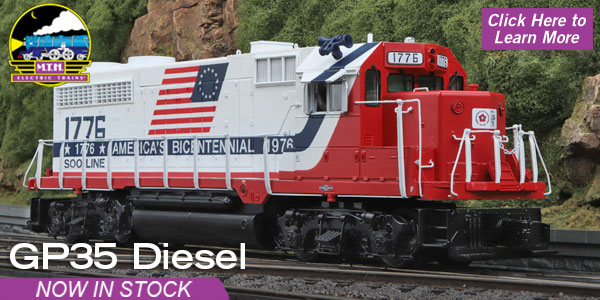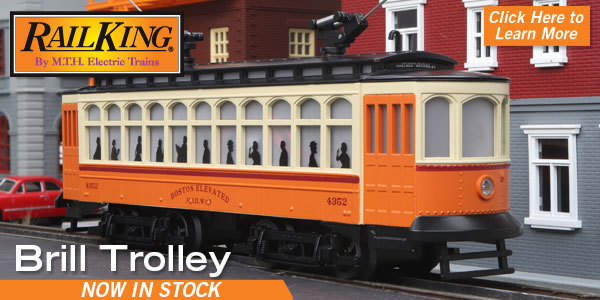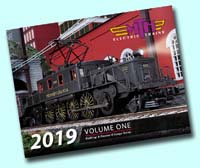 |
|||||||
|
|||||||

Produced from 1963 to 1966, the GP35, along with its six-axle SD35 sibling, marked both an end and a beginning. They were the last road diesels to use the EMD 567 motor that had powered switchers, F-units, and Geeps since 1939 (so named because each cylinder displaced 567 cubic inches). For the horsepower race of the 1960s, EMD tweaked the 567 to a turbocharged V-16 delivering 2500 hp. That was it for the 567, however, and in 1966 the baton was passed to the more powerful model 645. But while the "35 line" diesels ushered out an old motor, they inaugurated a new look. Their angled cab roofs and the clean, squared-off lines of their car bodies established the look of EMD power for the next three decades. Introduced to compete with General Electric's landmark U25B, which had ushered in the second generation of diesel power, the GP35 outsold the "U-Boat" nearly three to one. There was a strong market for new power in the mid-1960s because the first-generation diesels that had vanquished steam were wearing out. While first-generation rosters had often been a hodgepodge of manufacturers and models as railroads experimented with the new technology, by 1960 Alco, EMD, and GE were the only manufacturers left standing - and Alco would soon throw in the towel. As a result, virtually every major U.S. railroad became a GP35 customer, and over 1300 engines were sold in the United States, Canada, and Mexico. While our Premier model is not the first O gauge version of this second-generation pioneer, it offers the best combination of detail, realism, and performance of any 1/48 scale GP35. Added-on detail parts include windshield wipers, metal see-thru body grilles, lift rings, metal grab irons and handrails, see-thru rooftop fan housings, and brake cylinders, air pipes, and swing hangers on our super-detailed Blomberg trucks. And in command mode with the DCS system, you can create a lashup combining one or more GP35s with other Proto-Sound 3.0 or Proto-Sound 2.0 first- or second-generation power, and run them from a single throttle just like the prototype. In 1869, the year that rails first joined America's east and west coasts, two German immigrants skilled in cabinetmaking founded the J.G. Brill Company in Philadelphia. At first, John George Brill and his son George Martin Brill built any kind of rail passenger vehicle, including horse-drawn streetcars, cable cars, and passenger cars for steam railroads. The firm's fortunes improved dramatically in the mid-1880s, however, when it began to concentrate on the booming streetcar market. And as the twentieth century dawned, Brill became a leader as the streetcar business matured and consolidated. The firm absorbed many of its competitors, including the American Car Company in St. Louis, the G.C. Kuhlman Car Company in Cleveland, the John Stephenson Company in Elizabeth, New Jersey, and the Wason Manufacturing Company in Springfield, Massachusetts. These acquisitions gave the Brill Company access to strategically located plants in most parts of the country. Brill was also known for technological innovation. One of its earliest notable designs was the patented Brill Convertible Car; removable side panels enabled the same trolley to be an open car in warm weather and a closed car in colder seasons. Later, the patented semi-convertible design enabled the removable panels to be stored in the car's roof. Other Brill innovations included the Narragansett car, an open car with a patented two-step running board to facilitate boarding by women in tight skirts; heavy steel high-speed articulated cars built in 1926 for the Washington, Baltimore & Annapolis interurban; and lightweight, high-speed Bullet cars developed in 1930. The RailKing Brill Semi-Convertible Trolley features transit stop simulation available only from M.T.H. Designed specifically for our municipal transit cars, the unique Proto-Sound 3.0 transit program features Station Stop Proto-Effects, allowing you to program the trolley to stop automatically at designated transit stops, even in Conventional Mode. When configured to run on automatic, the Brill Semi-Convertible stops itself at locations you choose and calls out transit stops that you select in advance; the trolley essentially runs itself. And when you program the Semi-Convertible for an out-and-back route, it even reverses itself and heads back downtown when it reaches the end of the line - stopping along the way to broadcast the name of each stop and the hustle and bustle of passengers coming and going. |
2018 O Gauge Holiday OfferingsClick HERE to see it online. It's Easy To Add WiFi To Your DCS LayoutCheck Out The Quick Start VideoClick HERE To Learn More About DCS and WiFi Control 2019 Volume 1 CatalogClick HERE to see it online. |
||||||
| Follow Us On | |||||||
| © 2018 M.T.H. Electric Trains 7020 Columbia Gateway Drive, Columbia, MD 21046 (410)381-2580 |
|||||||






